Looking for an option to decorate the walls that would combine external attractiveness, practicality and accessibility? I can suggest at least one - an artificial brick for interior decoration. About the fact that this material is good and how to effectively use it in the interior as much as possible, read below.

What is good decorative brick and its imitation
The main thing is that distinguishes the decorative brick for the interior decoration of the walls from the usual natural analogue - weight. Artificial material is much thinner and several times easier, and accordingly, they can decorate all the vertical planes indoors without fear of creating an additional load on the bearing walls.
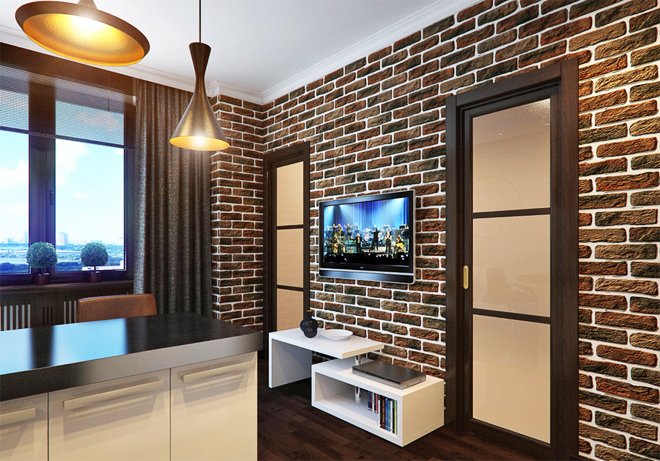
In addition to this important factor, I can not not mention other advantages of this type of finish. Who knows, can their listing make you at least think about the acquisition of such an interesting material?

So, what is good decorative brick:
- He is resistant to abrasion. Such material is not afraid of mechanical impact, which is why it can often be found in the hallway, near door openings Or other places that are polluted and rubbed faster.
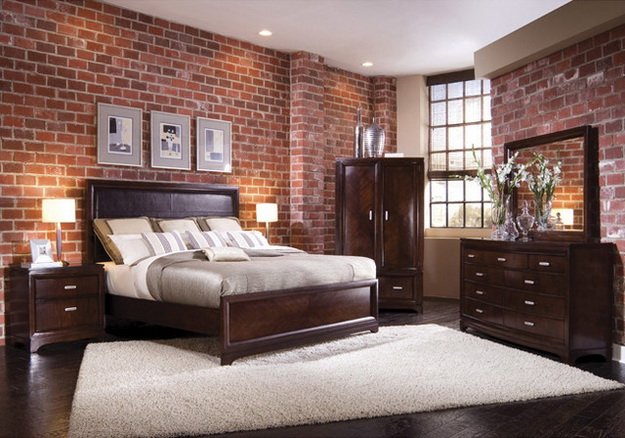
- It has high thermal insulation. Do not want to freeze with cold winter evenings? Facing brick will help in this, because it is able to reduce the loss of heat in the room. Useful function, isn't it?
- He is durable. Finishing the wall of once, you will be able to forget about the repair dozen years. Decorative brick does not fade, resistant to temperature differences and chemicals, so the need to replace it will not appear soon.

- Waterproof. Even without additional processing, the brick is well opposed to water, but if we open it with a hydrophobic solution, the water-repellent properties will become simply fantastic. In the process of cleaning, the material can be washed with a wet sponge using non-aggressive chemicals.
- High sound insulation. Here comments are superfluous, I think everyone can understand than a good such function in the conditions of thin partitions and walls.

- Absolute ecology. The material is manufactured on the basis of exceptionally clean natural components, so it will not be distinguished by any harmful compounds.
Agree, voiced advantages are quite impressive and beneficially distinguished material on the background of others, at least not eco-friendly options. But before telling about imitation brick masonry In the interior, a little silent the most popular types of artificial bricks.

- Clinker. False brick, whose basis is clay. It is difficult to name the budget option, the high price is due to the complex manufacturing process, during which the material is subjected to burning.

Thanks to these manipulations, the clinker brick acquires elevated density and strength, and its color gamut is inhomogeneity. The material is widely used both for external and internal finishing works. In the interior it most often can be found as decoration of fireplaces, veranda and loggia. In the next section, I will tell you about it.
- Decorative gypsum brick - manual molding material: Special solution is poured into forms. After the mixture is frozen, it is removed from the forms, after the drying process begins.
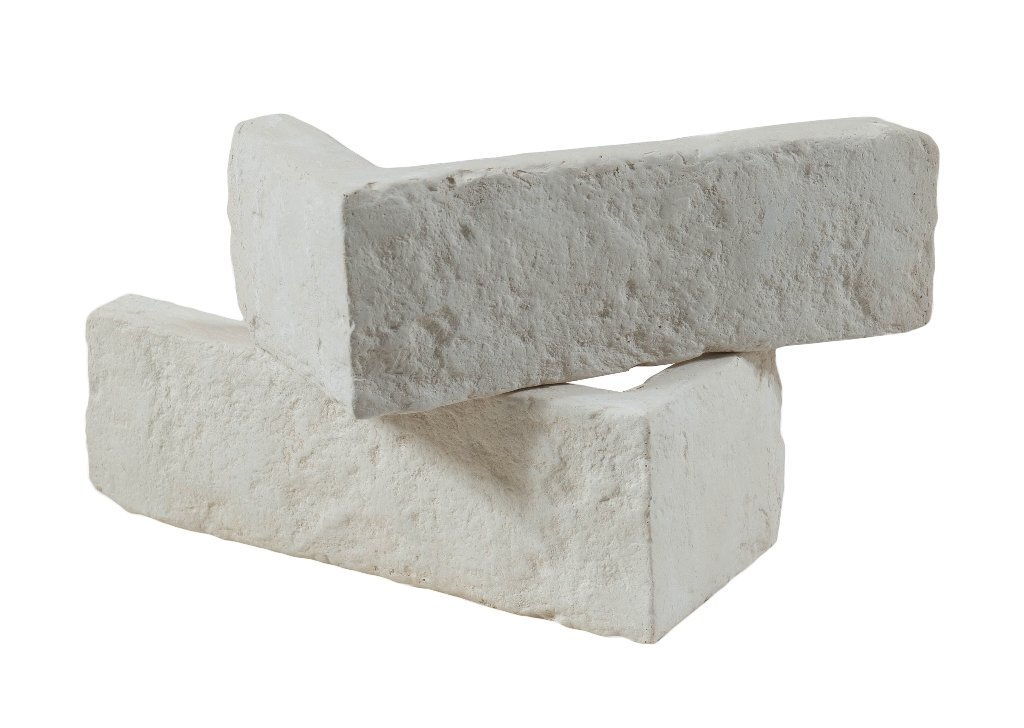
This option is used only for interior decoration, since such a gypsum tile does not tolerate heavy loads.
Features of the wall decoration under the brick

If a real brick for any reason is an inaccessible luxury for any reason, then other materials are entering, perfectly imitating brickwork. Can be used:
- building panels;
- tile;
- stylized wallpaper;
- stucco.
All of them will help create an original decor under the brick. Below I will stay at each option in more detail and consider their features.
Option number 1. Panels
Building panels are particularly demand among lovers of the "brick" decor. And if initially they were used for external cladding, now they can be met more often inside the house.
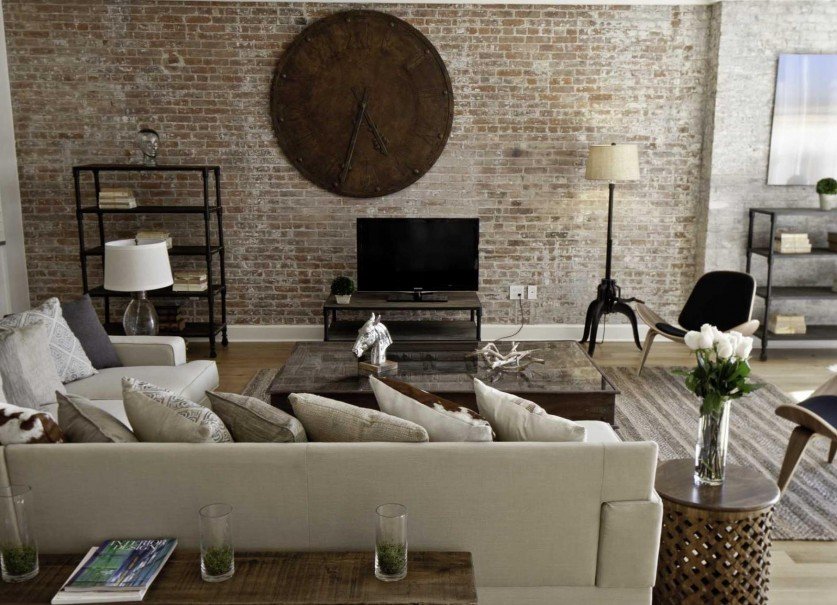
Made simulation panels from plastic, which makes them insensitive to dust, moisture or rust. Interior decoration Under the brick with the help of panels has high resistance to alkaline and acidic. The main advantages can also be attributed:
- ease of installation;
- a light weight;
- good sound insulation;
- presentable appearance;
- available cost.
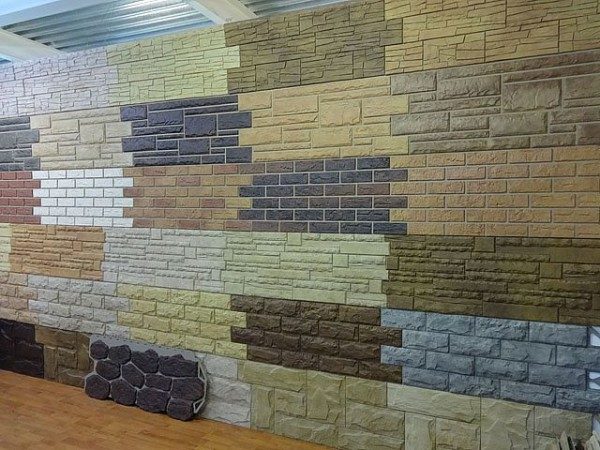
There is a fairly tangible drawback. Imitation of bricks for interior decoration panels sometimes needs an additional crate, because of what the extra centimeters of space are eaten. This is especially noticeable in small rooms.
Panels can be attached vertically or horizontally, everything will depend only on your preferences. You can mount them either on nails or screws or screws.
Option number 2. Tile

It is not much different from ceramic relative with its characteristics, thickness and masonry method. The surface of the material is covered with icing, allowing to keep the shade for many years.

To other benefits include:
- porous structure that looks very effectively;
- excellent thermal insulation indicators.
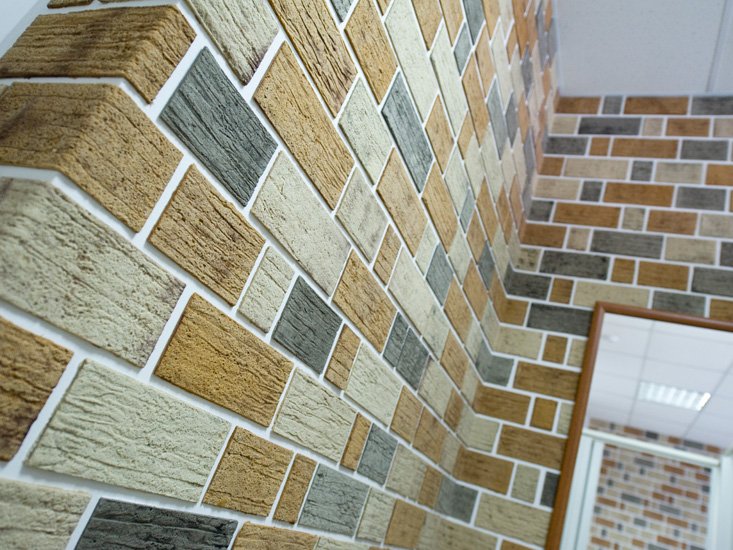
I recently found out that there is still a special flexible tile under the brick. The main feature of which lies in the fact that it can be borne in any direction. Accordingly, it allows you to use such material in the process of decorating columns, door or window openings.
Option number 3. Wallpaper
When the time and tools strongly limit you in the choice of available options, wallpaper can come to the aid to help with the imitation of the coating you. They will perfectly fit into the interior of almost any room, and the process of sticking does not appear to a sign of many.

In addition, after a few years, you without a special twist and pile of construction garbage, if you wish, can replace the wallpaper with another type of finish. Is it worth saying that the same decorative brick of plaster or clinker tiles will cost much more expensive?
Despite the advantages, minus such wallpaper is very tangible. Despite the ease of finishes and low cost, they will not be able to compete with better imitation, which is much more like a brick.

Option number 4. Plaster
Even the plaster you can create a magnificent imitation, and you can do it with your own hands. How will the plaster help in this case?
- It is diverse on texture and shades, and if necessary, paint will allow you to achieve the desired tonality.
- Plaster is easy to apply.
- It has good thermal insulating properties.
- It is environmentally friendly and durable material.

On the other hand, the dust attracts easily and just gets enough. So it is often possible to wash it.
Brick and interior
Artificial brick is not only material for lining walls in the apartment. For example, this is a great tool for zoning space, they also decorate the bar rack on the border of the combined kitchen-dining room.
I can not help but notice that it is widely used as an important focus in various interiors:
- Loft. Style that cannot be imagined without coarse brickwork. Most often, it decorates one of the walls of the room.

To achieve maximum effect, it is better to use artificially aged brick, which as if it carries the seal of time.
- Country For this style, most of the area are styled: walls, furnace or fireplace, door and window openings. Most often used bricks of reddish shades.
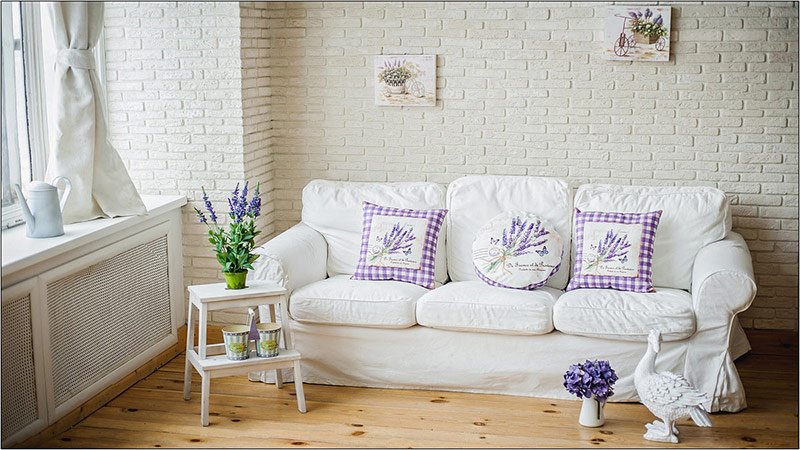
If any type of imitation can be used to decorate the walls, then for the lining of the furnace or fireplace - exclusively clinker.
- High tech. Here imitation of antiquities will be inappropriate, you should use perfectly smooth glossy brick. The color scheme is quite limited - it is better to give preference to gray or white shades.
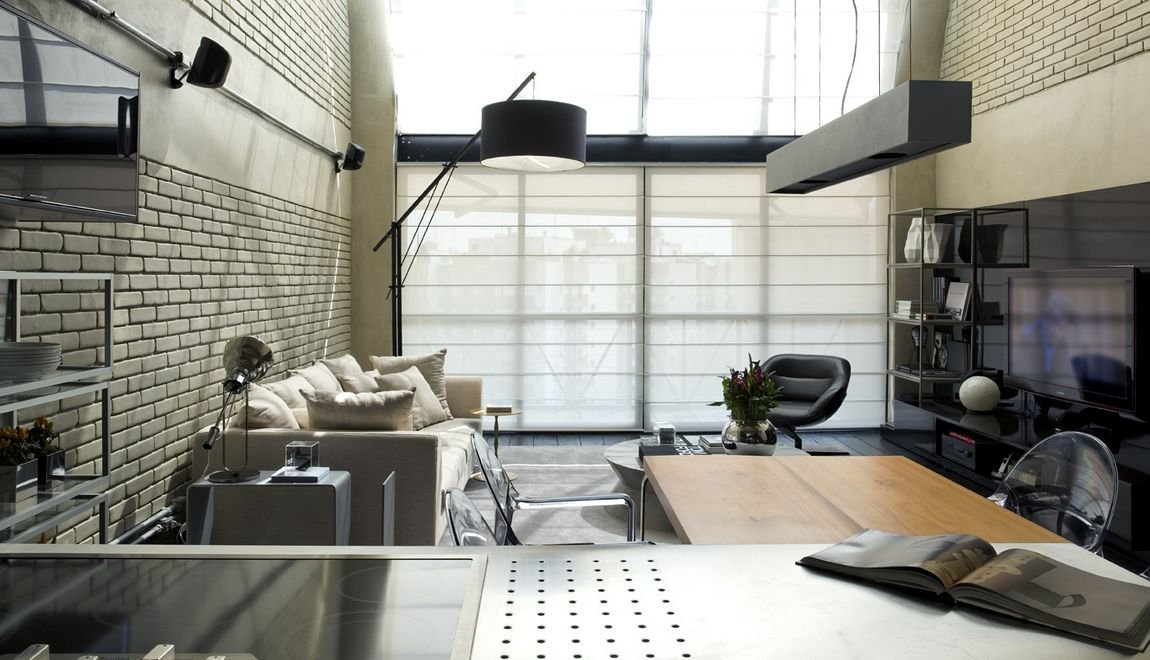
You can either arrange one accent wall, or decorate the columns in this way (if they are of course). Grouting for seams is worth choosing as close as possible to bricks so that it is almost indistinguishable from them.
- English style. When designing a kitchen, a complete cladding of all walls is allowed. But this is possible only with sufficient quadrature and present in the interior of others. natural materials - Ceramics, Tree, Stone.

5 O'Clock TEA will be even more pleasant on the background of a red brick wall
For a small kitchen, you can use the decorative tile under the brick and bind the apron.
Read more about the styling process
About the varieties of materials imitating brickwork, I told. It's time to tell about how to lay decorative brick for interior decoration on the example of a gypsum option. Separate repair work into several stages.

Preparation
To begin with, it is worth it to clearly imagine what final result you wish to achieve. You may want to even create an exemplary sketch (if you do not want to decorate the entire wall or want to determine the pattern). Next, you need to act according to the following scheme:
- Remove even the smallest remnants of wallpaper or paint.

- Degrease the surface. To understand what places especially need adhesion, it is enough to spray with water with water. Places where fat stains remained, you must additionally process mechanically.

- It should be a little scratching the wall - such a manipulation will make it so that the decorative stone was blurred under the brick, it will be better fixed on the surface.

The process of sticking
Immediately before starting repair work, make sure that you have everything at hand required tools. The finishing tile under the brick will not be able to equip firmly on your walls without:
- wooden hacksaws;
- spatulas of different sizes;
- putty;
- water-based lacquer;
- several kitchen sponges;
- file or sandpaper;
- construction level;
- pencil, which will be made of marks;
- construction mixer or drill.
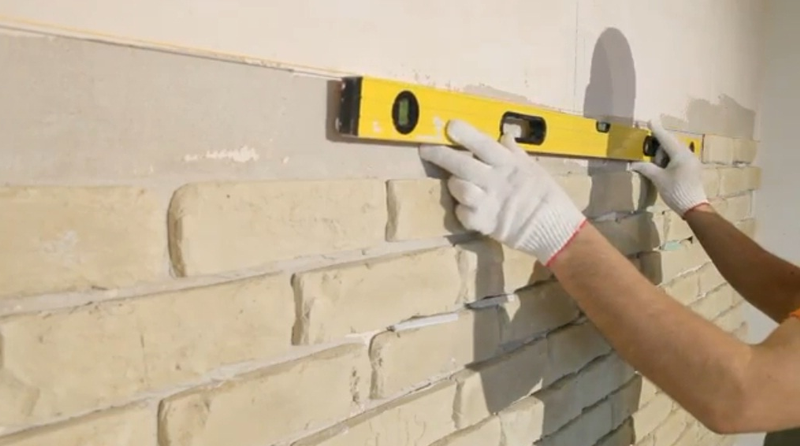
When the entire toolkit is assembled, you can go directly to the laying:
- Divide special glue with water before the formation of thick paste. You can mix ingredients using a building mixer.
- Check the half level. Decorative tile Under the brick, or rather, its first row, laid out at the floor.
- To achieve the most authentic stylization, lay the tiles of different sizes near each other.
- Starting from the second level, make sure that the new junction between the tiles does not coincide with the previous one.
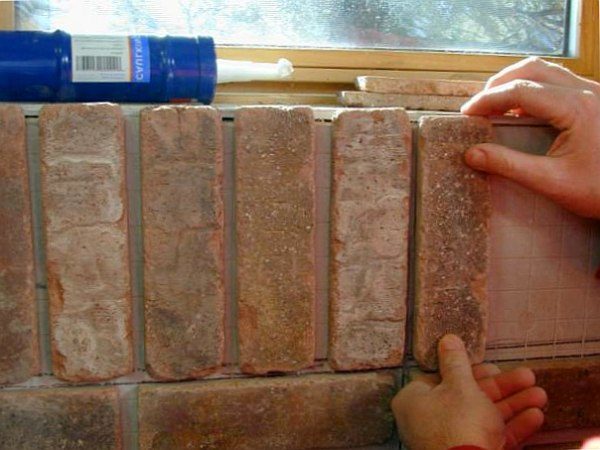
- If necessary, you can "verify" the tile to the necessary form of the agent. This is especially true in cases when decorating a rounded arch or other curly element.
- In order for the corners as best as possible to each other, they can be cut off with wort, and the places of drinking spil to the sandpaper.

- In the joints where the cutting was done, should be carefully walking with a putty.
- Skin all the white places of paint suitable shade.
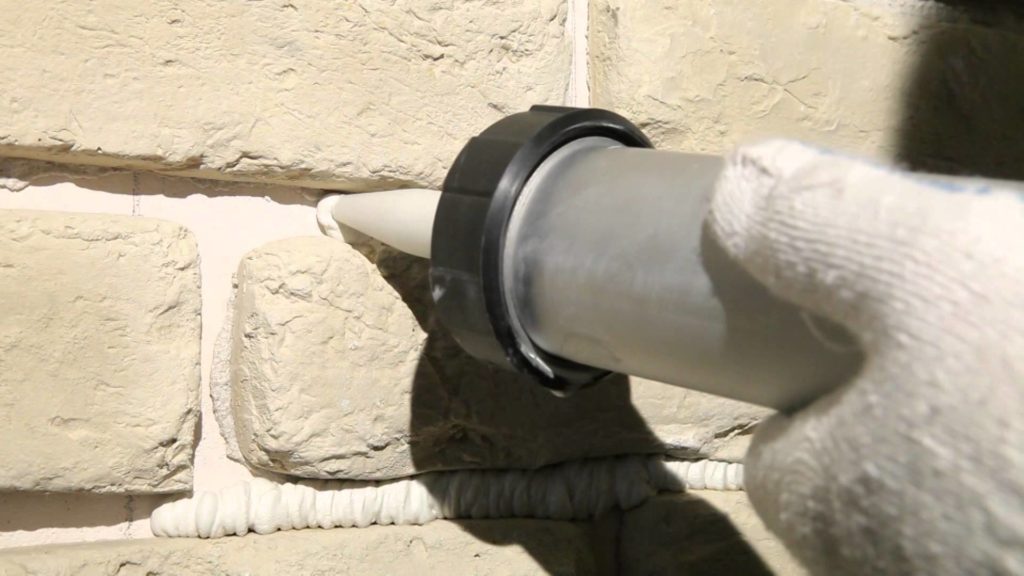
After the facing tile under the brick was installed, it can be lacquer. Here I recommend experimenting, having anticipated one element. If it seems to you that it began to glisten too, then you can dilute the lacquer with a small amount of water.
Finally
Imitation of brickwork is a fairly stylish and practical design solution that will benefitly complement the interior. I hope I was able to tell about its advantages and features.
Having studied the way to decorate, I already think about using it in the interior!

If you have any questions about me on the topic, ask them in the comments below. I also ask to unsubscribe those who already use a brick for interior decoration. Share your impressions and experience.
October 30, 2016.If you want to express your gratitude, add clarification or objection to ask the author - add a comment or tell me thanks!
Internal decoration brick is performed quite often. It is due to the fact that the material itself has a rather unusual design and for some premises with it is created a unique interior.
Finishing internal under the brick can be performed on any surface. For this, currently there is a huge amount of modern materials.
Combinations:
- It is quite interesting to combine such a type of cladding with plaster or stone, which can be natural or decorative.
- Also common is the cracking of the adjacent surface with.
The photo shows examples of such a design room.
Materials that can be used under brickwork

Interior decoration under the brick is performed today with such materials:
- Directly brick or decorative it.
- Panels with imitation of brickwork.
- Porcelain or under brick.
- Artificial stone.
Brick for decoration
In order to arrange a premises using a silicate or other type of brick. Mounting such material on the surface will not work.
From it, walls that have high strength and durability are erected.
Characteristics:
- Brick moisture resistant and not capable of perceiving moisture and pollution on its surface. It does not burn and resistant to all temperature fluctuations. He is not terrible frost.
- The dimensions of such a finishing brick can be standard as the construction. As a rule, the brick is hollow, which makes it possible to increase the thermal insulation properties of the room decoration.
Note. Color range of bricks is rather diverse. Material laying is performed similar to the building brickwork. To do this, use a solution of concrete. Its thickness when laying should not exceed 1 cm.
Decorative brick in decoration
Unlike the construction brick, decorative has a little different properties and characteristics. Its color gamut is much wider, which makes it possible to create a unique interior of the room.
There is:
- Red and white.
- Yellow and brown.
- Green and bard and others.
Consider more Materials:
- The weight of the material is also less and it does not have full-scale forms and sizes like a brick for construction. In appearance, it is a small panel, the height and length of which correspond to the size of the brick.
- The thickness of such panels is not more than 1 cm. Such bricks are made for internal finishes from clay test or concrete solution. At the same time, various production technologies are used.
- The surface of the material may be smooth or structural. There are rough surfaces. They are in the finish of great popularity.
The facing brick of this type has:
- Durability and practicality. Thanks to the latest technologies for manufacturing material, its surface is not able to perceive the effects of moisture and dirt and for this reason does not require careful care.
The service life of bricks is almost unlimited. - Wear resistance, since external design for the entire period of operation does not change. The structure of the material remains the same.
- Fire resistance and frost resistance. It does not respond to the impact of various temperature regimen.
- Strength. On its surface, the brick can withstand quite large mechanical and physical impacts.
Preparation of the surface to the installation of decorative brick

All works of this type are performed quite simply and on the principle of performing similar to the installation of ceramic tiles.
The surface must be well prepared. To do this, it takes purification, alignment and priming.
Council. If the surface is smooth, it will not need to align it. The most important thing is to clean and brew it right.
Work:
- Initially, the surfaces are eliminated by the layers of paint and plaster, which has already moved away from the surface. The paint is washed off by a special tool, and the plaster - with the help of a spatula and hammer.
- After that, on the plots that remained without plaster is applied and is well treated after drying with emery paper. Then the surface is washed away and only then it is ground.
If you want to align the entire surface, then you will need to use:
- Plasterboard.
- Stucco.
So:
- It is due to the fact that the material is attached to the profile metal frame, which is pre-manufactured on the surface. It has a certain height, which is at least 4-5 cm.
- The joints of the sheets of plasterboard are masked by putty and only then ground. You can already mount any finishing material.
- The use of plaster is characterized as a very long and rather labor-intensive process. Initially, the layer of starting plaster is superimposed on the surface.
After that, the finishing is used. Everything is processed in the process of alignment by sandpaper.
Council. It is worth considering that the start of the "Start" has a coarse-grained structure and it is necessary to process it only by coarse sandpaper.
- In order for each layer of plaster to be smooth, a construction level and a special grid, which is attached to the surface works.
- Plastering is also subjected to priming.
Council. Surface priming work is performed at mandatory, as they can increase the strength of the trim bond with the surface itself.
Installation of decorative bricks

Works on fixing on the surface of decorative brick are easily performed with their own hands.
It will take:
- Platecores or other fixture for cutting material.
- Construction level providing smooth installation of each brick.
- Solution of glue or concrete.
- Spatula.
Work:
- In order to prepare a solution of concrete, there is an instruction, according to which sand and concrete is added to the container of a certain size in proportion 1 to 3. The water is added during the mixing process.
Council. For such actions, it is best to use a concrete mixer or a building mixer.
- The solution is superimposed on the surface of the wall, and not on the back side of the material. The thickness of the layer should not exceed 0.5 cm.
Brick for interior decoration is laid at a certain distance from each other. Its size can be 0.2 or 0.3 cm. For this, cross-shaped beacons are used.
Panels for decoration under brick
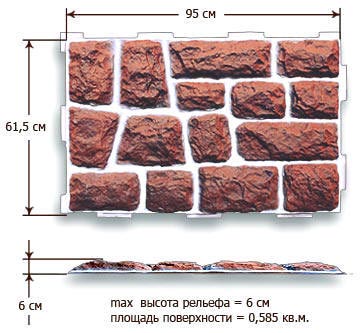
Internal under the brick is quite often performed decorative panels, on the surface that is imitation of brickwork.
They are made from:
- Sheet aluminum.
- Plastic.
- Siding.
Product characteristics:
- Material is distinguished by its practicality. All types of moisture-resistant panels and are not able to absorb dirt on their surface.
They are durable, as they can be operated for 15-20 years. The price of them is quite different.
It all depends on the cost of raw materials. Plastic panels are considered the cheapest. - They do not burn and freely perceive the effects of high and low temperatures. The weight of the panels is small and for their installation will not need to increase the surface.
Only here it is worth considering that the surface should also be prepared.
Preparation of the surface to install panels
IN preparatory work It includes a construction on the surface of the crate.
Council. Align the surface for such work is not required.
It is made of a lamp from:
- Wooden planks.
- Metal profiles.
Council. For premises, in which there is a very high air humidity, it is best to give preference to metal profiles.
Stages of work:
- The lamp is mounted with the help of dowels and screws. It is possible in the process of work in parallel except for decoration to make and insulation of the room.
For this there is a foam and expanded polystyrene. - These materials go in the formation and are quite simply cut with the help of a stationery knife.
Council. So that the insulation is tightly inserted into the cells of the crates, it is necessary to cut it in accordance with the sizes of the cells.
All joints of the material with the crate are labeled by mounting foam.
Installation of decorative panels
Installation of such a material is performed on the prepared surface is quite simple.
It is used for this special glue or self-tapping screw. It all depends on what the panels are made.
Note. You will also need a material cutting tool. For metal, a hacksaw or scissors are suitable for metal, but for siding or plastic - Bulgarian. The video shows the installation process of decorative panels.
Decorative stone under brick

Artificial stone under the brick can be made of:
- Acrylic.
- Gypsum.
- Synthetic substances.
- Sand and concrete.
Characteristic:
- The sizes of the stone can be similar to the size of the brick, only the thickness of the material is not more than 0.7 cm. The external design of artificial stone under the brick can be of different colors.
This allows you to create any design room design. - The weight of such material is very small. For its installation, unlike natural stone, it will not be necessary to strengthen the surface.
To install, you will need:
- Special glue or concrete solution.
- Building level.
- Platekorez.
- Putty knife.
- Crusading lighthouses and decorative puttage.
It is quite durable and durable. He also does not absorb moisture and dirt.
It does not burn and does not melt. It is mounted very quickly and simple.
The principle of work is similar to installation decorative bricks or ceramic tiles.
Imitation of bricks for interior decoration is an interesting design solution. It can be used for the integer room, and to allocate any zones, walls. Many wonder: "How to do this, not to collapse the walls before masonry?"
Yes, and not always erect them from bricks. The variants of the materials themselves and ways to make a set of priests. Two large groups can be distinguished: brick imitation for interior decorations using purchased materials and made with their own hands from remedies. It is worth disassembling this topic more.
Preparatory work
This stage will be for all species. finishing materials The same, with the exception of PVC and MDF panels.
- You should remove the old material.
- Shawland deep flaws on the wall.
- Progress the surface.
- If necessary, plastering the walls to an even state. Okrew, primed.
Wallpaper
This type of material is the easiest way to embody such a designer solution. For this decoration, it is important:
- Smooth base. There should be no waves, deep flaws and bulges.
- Compliance with pasting technology. So as a result of on the joints of the canvas, gaps were not formed.
But the fact is that even vinyl thick wallpapers will not create completeness of the sensation of natural masonry. As you can see in photos, more or less real imitation of bricks for interior decoration is achieved with 3D wallpaper.
The rest of the species, unfortunately, do not convey the masonry texture visually.
PVC panels
An interesting solution for rooms with high humidity and aggressive medium. This type of material is easy to caring, wear, for its constructive can be hidden communication. Where better to use? Imitation of bricks for the inner will add a highlight, will help get away from standard solutions in the design of this room. In the photo you can see one of these use options.
Stages of work:
- As such preparation of the foundation, this type of facing does not require.
- The perimeter is collected frame for panels using guide and rack profiles. Since the finishing material is lightweight, hard frame will not need. If only it is not planned to warm the walls.
- Next on the perimeter is attached starting plastic profileif not planned to close by others decorative elements Perimeter walls. It is better to use corners, profiles, plinth under the color of the main material, then imitation under the brick for interior decoration will reach a greater effect.
- The most responsible moment is the docking panels. It should be as close as possible to the canvas so that the gap is not formed between them.
Two minuses should be allocated:
- At a certain angle of lighting the joints between the canvases can be viewed.
- Plastic can not be attributed to natural materials.
As can be seen in the photo, the panels can be textured and looked quite realistic.
Where else can this brick imitation for interior decorations can be used? Plastic can show itself when operating in the bathroom, toilet, corridor. For such premises, he will be perfect. First, it does not absorb water, and secondly, it is easily washed away from any kind of contamination.
Clinker tile
Imitation of bricks for interior decoration This option is one of the most popular. 
This material Create the most realistic as a rule, is produced by the canvas, on which several rows of bricks are "posted". It simplifies and speeds up the cladding process. Mounting method:
- The base should be more or less smooth trunk.
- The glue is stuffed. First applied to the base. Usually at once processed no more than one square meter. Next - on the tile. Masonry lead from bottom to top. Works must be performed with level control. It is impossible to pick up perfectly under the wall so without cutting can not do.
- After drying the surface, you need to close the seams of grout.
This type of facing is used as part of the decor. Apply in the interior of living rooms, corridors.
 Very often used for facades. This is one of the most realistic types of trim under brickwork.
Very often used for facades. This is one of the most realistic types of trim under brickwork.
Ceramic tile
This material is easier than the previous version, but also complicated in the installation process itself. 
It is better to choose plates with a simulation of several bricks. This will make it easier and speed up the cladding process. The principle of work is similar to the previous option. It can be noted that the facing - sophisticated view Finishes and better trust a professional. But if you still want to do it yourself, the laying technology should be performed. No need to rush - observe the sizes of the seams.
Such imitation under the brick for the inner room, the toilet, the kitchen will be an excellent solution, because it is withstanding the direct hitting of water, it is easy to wash away from any contamination. The images represented show several designer ideas for the design of these premises.
Gypsum tile
This option should be noted separately, because it is possible to make such a facing not only by purchasing the material in the finished execution, but also making it yourself. This will require: gypsum plaster / putty, box for brick size. It should be noted that the most popular imitation of bricks for interior decoration is performed as a spoonful masonry. Dimensions Spoon of standard brick 65 x 250 mm. That is, the container is required to choose either the same size or approximate to it. The process itself is simple:
- To knead the solution. It should be embedded by one portion, because it has a property quickly stick.
- Will a complete setting of the solution. Pull out.
Of course, the production process will accelerate if there are several tanks. You can add a coloring substance immediately into a gypsum solution or scrolling the finished surface. After the plates are ready, they are glued similar to the previous two options. After the frozen, they are scratching the desired color. It is possible for greater realism to lend irregularities. The seams are also crossed with imitation solution for masonry. Either simply leave unclaimed, depending on the resulting lining solution.
Plastering and putty imitation
This species can be quite worthy to imitate if you spend the work.

A layer of plaster or putty is applied to the wall, a short time is given for grazing, and then the masonry pattern is squeezed with a finger or reverse side of the spatula.
For this option, the applied layer should not be carefully aligned.
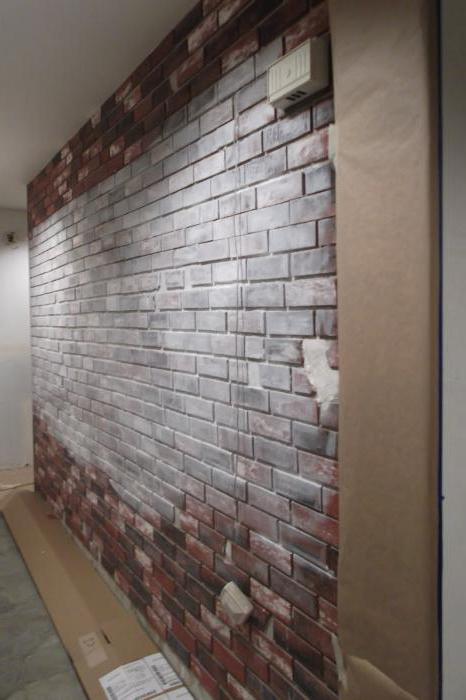 The irregularity of the surface will create more realistic imitation. Another nuance is not worth putting stucco with large areas. The solution can quickly dry and apply the picture will be difficult.
The irregularity of the surface will create more realistic imitation. Another nuance is not worth putting stucco with large areas. The solution can quickly dry and apply the picture will be difficult.
After completing the work, the layer must dry. And then the paint is applied under the required hue. Irregularity can be replaced.
Imitation bricks for interior decoration with your own hands
You can allocate a number of options available for our own production:
- Paint. The cheapest and simple option. This will require paint for color. facing bricks. Prepared stencil for masonry. You can use cardboard, plastic - as it is more convenient. And then the wall is scratched, she enhances and on top of it with different color through the stencil, the seams are applied. This kind of close is not very similar to the original, but from afar looks plausible. You can use, for example, for the design of the balconies.
- Another of the budget executions. Cut bricks from thick cardboard (you can use packaging material). Stick on the walls, leaving gaps for seams. Next, the entire plane is to cry the napkin, it should be pre-squeeze, then straighten. This will help the surface to give the texture. And in conclusion to cry. For such a type of finish, a fine-grained foam can be used,
 What does brick imitation look like for interior decoration? The photos presented in our article give an answer in detail. Relying on this article, you can choose an interesting design solution for accommodation.
What does brick imitation look like for interior decoration? The photos presented in our article give an answer in detail. Relying on this article, you can choose an interesting design solution for accommodation.
With regard to the selection of material for finishing is an individual solution. The only advice: Before purchasing, it is necessary to familiarize yourself with the characteristics and properties of the material. And then decide on the purchase.




